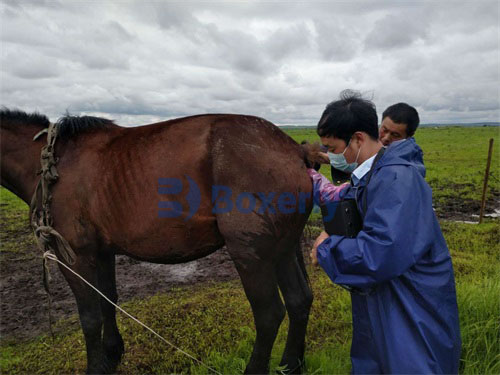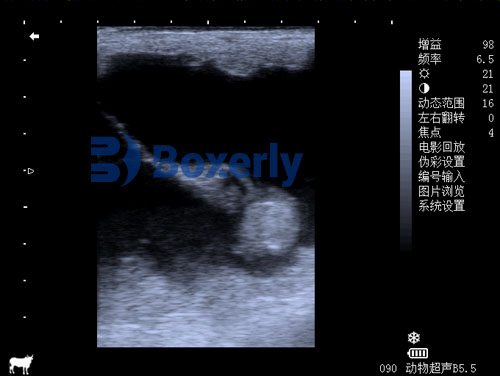Pregnancy detection in mares is one of the most important tasks for horse breeders and veterinarians. Knowing whether a mare is pregnant, and understanding how the pregnancy is progressing, allows for better management of breeding programs and foal care. Ultrasound is now considered the gold standard for equine pregnancy detection, offering accuracy, safety, and clear insights into reproductive health. But how exactly does this process work, what advantages does it bring, and why is it trusted by veterinarians worldwide? Let’s take a closer look.

Why Pregnancy Detection Matters in Horses
Breeding horses is both an economic and emotional investment. Owners need to know early whether a breeding attempt was successful. If a mare is not pregnant, she can be rebred quickly instead of waiting months to find out naturally. Early confirmation of pregnancy also allows the vet to check for twins, which can cause serious complications.
Traditionally, veterinarians used rectal palpation to detect pregnancy. While effective in skilled hands, palpation does not offer the same clarity as ultrasound. Ultrasound provides a visual confirmation, making it easier to detect pregnancies at earlier stages and with fewer errors. This improves overall breeding efficiency and reduces the risks to both the mare and foal.
How Ultrasound Works in Equine Pregnancy
Ultrasound uses sound waves to create images of internal structures. In equine pregnancy detection, a specialized probe is inserted rectally to scan the uterus. The probe sends out high-frequency waves, which bounce off tissues and fluids inside the mare. The returning signals form a picture on the ultrasound screen, showing the veterinarian whether an embryo or fetus is present.
This method is both safe and reliable. It allows the veterinarian to check not only for the presence of pregnancy but also for important details such as the number of embryos, their position, and the condition of the uterus. Over the course of the pregnancy, repeat ultrasounds can monitor fetal development and detect potential issues early.

The Timeline of Equine Ultrasound Pregnancy Checks
Different stages of pregnancy can be confirmed by ultrasound at specific days after ovulation. Each stage reveals unique information.
| Day of Pregnancy | What Can Be Seen on Ultrasound |
|---|---|
| Day 10–12 | First detection of the embryonic vesicle (small fluid-filled sac). |
| Day 14–16 | Clearer view of the vesicle, ideal time to check for twins. |
| Day 20–25 | Embryo visible inside the sac, heartbeat can often be detected. |
| Day 30–35 | Fetus more developed, strong heartbeat confirmation. |
| Day 45–60 | Fetal organs begin to form, movement may be visible. |
This timeline shows why ultrasound is so valuable. Instead of guessing, breeders can receive clear answers at different points in the pregnancy. Early detection helps with decisions about rebreeding, and later scans ensure that the fetus is developing normally.
Advantages of Ultrasound Over Other Methods
One of the main reasons ultrasound is favored over palpation or blood tests is the level of detail it provides. With palpation, a vet might feel an enlarged uterus but cannot visually confirm the presence of a fetus. Blood tests can measure hormone levels, but false positives and timing issues may occur.
Ultrasound, by contrast, offers a direct image. It allows for twin detection, which is critical in horses because twin pregnancies are usually unsafe. In addition, ultrasound enables monitoring of uterine health, detecting cysts, fluid buildup, or infections that could affect fertility. This makes it a multi-purpose tool, not just for confirming pregnancy but also for managing reproductive health overall.
Common Challenges and Considerations
While ultrasound is highly effective, there are still challenges to keep in mind. The procedure requires skill, as inserting a probe into a mare’s rectum carries some risk of discomfort or injury if done improperly. Proper restraint and handling are important to keep both the horse and veterinarian safe.
Another consideration is cost. Ultrasound equipment represents an investment for veterinary clinics, and clients must be willing to pay for the service. However, compared with the cost of a missed breeding season or complications from an undetected twin pregnancy, the investment often pays for itself many times over.
Some mares may also show false signs of pregnancy, such as weight gain or changes in behavior. Ultrasound cuts through these uncertainties by providing visible, undeniable confirmation. This reliability is one reason breeders rely on it year after year.

The Role of Veterinary Expertise
Technology alone is not enough; interpretation matters just as much. An ultrasound image is only as useful as the veterinarian reading it. Experienced equine vets can identify subtle changes in the uterus or fetus that might indicate a problem. For example, detecting fluid where it should not be, or recognizing developmental delays, can help guide treatment decisions.
This human expertise, combined with advanced imaging, makes ultrasound a trusted standard in equine reproductive management. Owners can feel confident that they are receiving accurate, science-based answers about their mare’s pregnancy status.
Conclusion: The Gold Standard for Equine Pregnancy Detection
Ultrasound has revolutionized the way horse breeders manage reproduction. By offering early, accurate, and detailed confirmation of pregnancy, it reduces guesswork and improves outcomes. From detecting a heartbeat at 25 days to monitoring fetal development at 60 days, ultrasound gives breeders and veterinarians the confidence to make informed decisions.
While other methods exist, none provide the same level of clarity and reliability. For anyone serious about equine breeding, ultrasound is not just an option—it is the gold standard for pregnancy detection.
link: https://www.bxlimage.com/nw/1294.html
tags: equine pregnancy detection horse ultrasound mare breeding veterinary reproduction ultrasound in horses pregnancy diagnosis in mares twin detection horses







